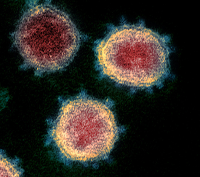–by Michael Riordan, excerpted from Northwest Citizen —

Comparisons of the Covid-19 public-health responses and data from San Juan, Skagit, and Whatcom Counties reveal striking differences that may help these counties and Washington state chart a viable path forward beyond the current crisis.
The novel coronavirus SARS-Cov-2 crept northward from King and Snohomish Counties in February, when the possibility of community transmission by asymptomatic individuals was poorly understood. On March 10, both Skagit and Whatcom Counties reported their first confirmed cases.
That same day, what is being called a “super-spreader” event occurred at the Mt. Vernon Presbyterian Church, where the Skagit Valley Chorale was holding a rehearsal that evening. Precautions were taken, including recommendations that members experiencing flu-like symptoms stay home. But “one person felt ill, not knowing what they had,” said Lea Hammer of the Skagit County public-health department. That person “would end up infecting 52 other people.”
It was previously thought that communication of the disease could occur mainly through coughing or sneezing, which would emit large droplets on which the virus could travel up to six feet — or by touching surfaces on which these droplets might have fallen. But an April 1 National Academy of Sciences letter reviewing the rapidly emerging scientific literature suggested that normal breathing could be responsible, too. Ultrafine aerosol particles, able to remain aloft for hours, can cause significant transmission.
The choral-society outbreak put a somber exclamation point on this conclusion. By late March, two of its members had died of the disease. And this pivotal event most likely enhanced the rapid Covid-19 spread throughout northwest Washington.
On Friday, March 20, San Juan County reported its first case of Covid-19 after tests results came in. “The patient is isolated and being treated at home,” noted Public Health Officer Frank James, M.D., in a press release. “County Health staff have contacted a small number of people who have had close contact with the patient. These individuals are being guided to quarantine themselves at home and to monitor themselves for fever and respiratory symptoms for 14 days following their last exposure.”
Asked the following day whether these “close contacts” would be tested for the disease, Dr. James lamented how difficult it then was to get anybody tested, given the scarcity of testing materials and laboratories qualified to evaluate the tests. Washington’s Department of Health, he said, was limiting testing to health-care workers, emergency medical technicians, and individuals over 65 experiencing flu-like symptoms.
Islands residents were understandably concerned, given the aged population and lack of sufficient hospital facilities. Persons who experience life-threatening symptoms have to be airlifted to mainland hospitals, which can take up to an hour.
In a March 23 Orcas Issues posting directed at San Juan County officials, Orcas Island resident Joe Symons wrote, “Please take immediate action to restrict non-resident access to SJC for a minimum of 90 days and make the resolution renewable.”
READ FULL ARTICLE: https://nwcitizen.com/entry/the-testing-of-three-northwest-counties
**If you are reading theOrcasonian for free, thank your fellow islanders. If you would like to support theOrcasonian CLICK HERE to set your modestly-priced, voluntary subscription. Otherwise, no worries; we’re happy to share with you.**








